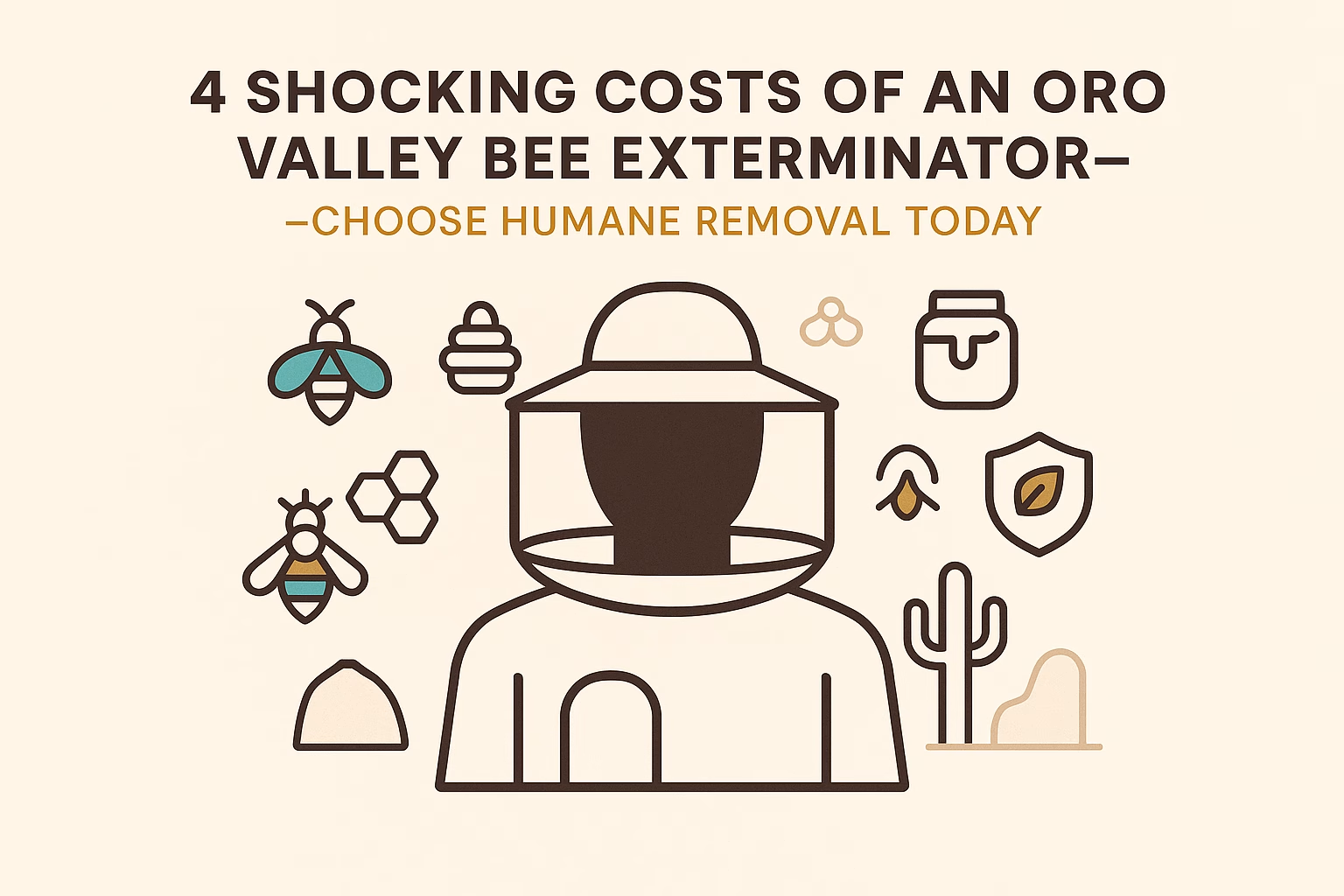Introduction
If you’re Googling “Oro Valley bee exterminator,” you’re likely dealing with a swarm on a tree or bees moving in behind a wall—and you need fast, safe answers. Many homeowners assume extermination is the quickest fix. But here’s the catch: killing bees often leaves comb and honey inside your structure, which can cause leaks, odors, and even new infestations.
The smarter approach is to choose humane bee removal Oro Valley services that perform live bee removal, remove comb and honey, sanitize the area, and bee-proof the entry points. That’s the difference between a temporary patch and a long-term solution that protects your home, your family, and local pollinators. If you’re weighing a bee exterminator vs removal, this guide lays out what you need to know.
Oro Valley Bee Exterminator vs Humane Removal: What’s the Difference?
Bee exterminator vs removal: outcomes for your home and for bees
An Oro Valley bee exterminator typically uses pesticides to kill bees in place. The problem? Many extermination-only treatments do not include comb and honey removal. That leftover material can melt in our heat and attract pests. In contrast, humane live bee removal involves safely collecting the bees for relocation and removing all comb and honey from the void.
Why does comb removal matter so much? University of California experts explain that abandoned comb and honey can leak, produce strong odors, stain drywall, and attract ants, roaches, and rodents if not removed. See the guidance on unwanted bees from UC Riverside at why comb and honey must be removed.
The bottom line: Humane removal reduces property damage, prevents reinfestation, and supports local ecosystems—while extermination often creates new problems behind your walls.
Safety realities in the Tucson–Oro Valley area (including Africanized honey bees)
Southern Arizona is home to Africanized honey bees (AHB). Most times they behave like other honey bees, but they can defend their nests more vigorously when disturbed. The National Park Service’s local guidance for the Tucson region emphasizes practical steps: don’t swat, seek shelter, and call professionals. Read more at Africanized honey bee safety in Saguaro National Park.
Humane removal providers use science-based methods and proper protective gear to control risk, avoid unnecessary chemical exposure, and protect both people and property.
The Hidden Costs of Extermination in Oro Valley
What happens when comb is left in walls, roofs, or voids
When colonies are killed without removing comb and honey, Oro Valley homeowners can face:
- Melting wax and honey seepage in hot weather that stains ceilings and walls
- Strong odors from fermenting honey or dead bees
- Secondary pests like ants, roaches, carpet beetles, and rodents drawn to the food source
- Reinfestation as new swarms are attracted back to the smell of old comb
Extension programs consistently warn against killing bees without removing comb and honey for these exact reasons. See the University of Maryland Extension’s guidance at why not to leave comb in structures.
Why humane removal is a smarter long-term investment
A thorough, humane bee removal Oro Valley service typically includes:
Humane Bee Removal & Relocation
Need Safe, Ethical Bee Removal in Tucson?
Seeing a swarm or bees entering a structure? Call now to speak with a Tucson beekeeper for fast, humane bee removal and professional guidance.
Call (520) 300-7233- Locating the colony and safely opening the cavity
- Live bee removal (often with a gentle bee vacuum)
- Comb and honey extraction to eliminate future damage
- Sanitization to remove pheromones and odors
- Bee-proofing entry points to prevent return
Not every situation calls for immediate intervention. Swarms—those clusters of bees resting on a branch or wall—often depart on their own within a day or two if undisturbed, while established colonies need removal and full cleanup. UC Riverside’s resource explains the difference and what to expect from swarms at swarms vs colonies.
How Humane Bee Removal in Oro Valley Works
Live bee removal: step-by-step process
While each property is unique, reputable providers usually follow a proven process:
- Site assessment: Identify whether it’s a swarm or established colony and locate the nest cavity.
- Safety setup: Establish safe working zones and protective equipment.
- Gentle extraction: Use a low-suction bee vac or manual collection to remove bees alive.
- Comb mapping and removal: Open the void, remove all comb and honey, and document the work.
- Sanitize and deodorize: Clean the cavity to remove pheromones that attract new swarms.
- Bee-proofing: Seal entry points with durable materials suited to the structure.
- Repair planning: Coordinate stucco, drywall, or roof repair as needed.
- Relocation to an apiary: Transfer bees to equipment managed by beekeepers when safe and appropriate.
In Southern Arizona, many providers maintain or partner with local apiaries. See an example of relocation-minded beekeeping at how beekeepers manage rescued colonies.
When extermination may be necessary—and how pros still protect your home
In rare, immediate-threat scenarios (for example, a highly defensive colony endangering people or pets), ethical providers may recommend extermination. Even then, professionals should still remove the comb and honey, sanitize, and seal entry points to prevent property damage and reinfestation.
Identify Swarms vs Colonies: When to Call an Oro Valley Bee Exterminator Alternative
Swarm vs established colony: what you’re seeing
- Swarm: A temporary cluster of bees (often the size of a football or larger) resting on a tree, fence, or wall for 24–72 hours while scouting a new home.
- Established colony: Bees entering and exiting the same hole or crack for days or weeks, often with a steady flight path—this usually means comb and honey already exist inside.
For Arizona communities, the University of Arizona Extension recommends avoiding disturbance and calling qualified professionals for assessment. Learn more at wild honey bees in community environments.
Timing matters: why fast, humane action saves money
Acting early can:
- Limit the size of openings needed to access the colony
- Reduce repair costs and time on site
- Increase the chances of a successful live bee removal and relocation
Selecting a Humane Bee Removal Pro in Oro Valley
Credentials and questions to ask
Before you hire, ask:
- Are you licensed and insured?
- Do you perform live bee removal and relocation when possible?
- Will you remove all comb and honey and sanitize the cavity?
- How do you handle repairs (stucco, drywall, roofing)?
- Do you provide bee-proofing and a written warranty against reinfestation?
- Can you share local references and photo documentation of past jobs?
To find relocation-minded providers, check the Southern Arizona Beekeepers resource at local bee removal contacts.
Local expertise and networks
Experienced Arizona beekeepers can often relocate even Africanized colonies safely with the right techniques. See statewide networks at Arizona State Beekeepers Association and community resources at call a beekeeper in Arizona.
Costs, Warranties, and Insurance: What to Expect
Humane Bee Removal & Relocation
Need Safe, Ethical Bee Removal in Tucson?
Seeing a swarm or bees entering a structure? Call now to speak with a Tucson beekeeper for fast, humane bee removal and professional guidance.
Call (520) 300-7233What drives price in humane bee removal Oro Valley
Pricing depends on:
- Access and height (second story, roofline, steep terrain)
- Structure type (stucco, masonry, roofing material, soffits)
- Colony size and age (amount of comb and honey to remove)
- Opening and repair scope (cutouts and restoration)
- Urgency (same-day or after-hours service)
Warranties, documentation, and bee-proofing
Expect a professional to provide:
- Written warranty terms outlining coverage and duration
- Photo or video documentation of the hive location, comb removal, and sealing
- Bee-proofing recommendations and sealing of susceptible entry points
Humane Removal vs Extermination: Quick Comparison Snapshot
Bee exterminator vs removal at a glance
- Extermination: May be faster upfront but often skips comb and honey removal. This increases the risk of leaks, odors, pests, and future reinfestation.
- Humane live bee removal: Includes comb extraction, sanitization, and bee-proofing. Protects your property and relocates bees whenever safe and feasible.
Prevention After Live Bee Removal
Bee-proofing your home and landscape
After professional service, keep future colonies out with these steps:
- Seal structure voids, repair stucco cracks, and caulk gaps around utilities
- Install screens on attic, gable, and crawlspace vents
- Remove old comb/honey attractants from sheds, walls, and stored equipment
- Manage irrigation and sugary attractants (fallen fruit, open soda cans, outdoor trash)
- Stay safety-aware in Africanized honey bee country—avoid disturbance and call pros if you notice sustained bee traffic. See local guidance at Saguaro NP bee safety tips.
FAQs: Oro Valley Bee Exterminator and Humane Bee Removal
Can Africanized bees be relocated?
Yes—experienced beekeepers can often relocate Africanized colonies safely using proper methods and equipment. Explore statewide beekeeper networks at Arizona State Beekeepers Association.
Will bees return after removal?
Not if the job is done correctly. The key advantages of humane bee removal are full comb/honey removal, thorough sanitization, and sealing entry points. This combination eliminates the odors and access that draw new swarms.
Do swarms always need removal?
Not always. Many swarms leave within 24–72 hours if undisturbed. A quick professional assessment can prevent unnecessary extermination or disruption. Learn more about swarm behavior at UC Riverside’s guidance on unwanted honey bees.
What Pest Control Won’t Tell You: Competitor Methods That Create Costly Problems
Why “spray-and-pray” fails Oro Valley homeowners
Spraying a colony and walking away can leave thousands of dead bees, pounds of comb, and gallons of honey sealed inside your home—setting you up for leaks, foul odors, and pest invasions. University and extension programs repeatedly caution that comb and honey must be removed after any treatment. For evidence-based guidance, see:
- UC Riverside: Unwanted honey bees and structural concerns
- University of Maryland Extension: Honey bee management in structures
Understanding Bee Colonies in Structures
How colonies grow—and why that matters for removal
A small nest can become a multi-comb colony quickly in warm weather. As bees expand, they build more comb, store more honey and pollen, and deepen the nest into wall, roof, or soffit cavities. In Oro Valley’s heat, honey can liquefy and flow when a colony is killed in place. That’s why early, humane live bee removal with full comb extraction and sanitization is the most reliable way to protect your home.
Conclusion
If you’re searching for an Oro Valley bee exterminator, remember that extermination often leaves comb and honey behind—leading to leaks, odors, pests, and reinfestation. Humane bee removal Oro Valley services perform live bee removal along with full comb cleanup, sanitization, and bee-proofing, which protects your property and preserves local pollinators.
Choose a humane specialist instead of an exterminator. Contact a local live bee removal pro for a prompt assessment and a safe, long-term solution that keeps bees—and your home—out of harm’s way.
If you’re seeing bees, you need expert action. Call Now to get help.





